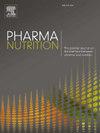Neuroprotective potential of saffron metabolites in Parkinson's disease
IF 2.4
Q3 NUTRITION & DIETETICS
引用次数: 0
Abstract
Parkinson’s disease (PD) is a debilitating neurodegenerative disorder characterized by the progressive loss of dopaminergic neurons. Although current pharmaceutical treatments mitigate symptoms, these frequently induce adverse effects and may not prevent disease progression, highlighting the need for safer neuroprotective alternatives. Natural products like saffron (Crocus sativus L.) have emerged as promising candidates due to their pharmacological and nutritional properties. While prior studies have investigated saffron and its extracts in the context of PD, no review has comprehensively analyzed the specific roles of its major secondary metabolites. Saffron’s bioactive compounds, particularly crocetin, crocins, and safranal, have demonstrated significant therapeutic potential across in vitro, in vivo, and clinical studies. Crocetin has been shown to inhibit α-synuclein aggregation and preserve mitochondrial integrity. Crocins exhibit neuroprotective effects, including inhibition of amyloid fibril formation, protection of dopaminergic neurons, and enhancement of synaptic plasticity through pathways such as PI3K/Akt/mTOR. Notably, picrocrocin remains unstudied mainly, representing a significant research gap. Safranal has shown efficacy in preclinical PD models, with promising effects on dopaminergic neuron preservation, motor function improvement, and apoptosis regulation. However, clinical trials are warranted to validate its therapeutic potential further. This review highlights existing findings, critically examines the literature, and identifies underexplored mechanisms, including neurotrophic and mitochondrial pathways, as promising targets for future research, ultimately paving the way for innovative therapeutic strategies in PD management.
藏红花代谢物对帕金森病的神经保护作用
帕金森病(PD)是一种以多巴胺能神经元逐渐丧失为特征的衰弱性神经退行性疾病。虽然目前的药物治疗减轻了症状,但这些治疗经常引起不良反应,可能无法预防疾病进展,因此需要更安全的神经保护替代品。藏红花(Crocus sativus L.)等天然产品由于其药理和营养特性而成为有希望的候选者。虽然已有研究对藏红花及其提取物在帕金森病中的作用进行了研究,但尚未有文献对其主要次生代谢产物的具体作用进行全面分析。藏红花的生物活性化合物,特别是藏红花素、藏红花素和藏红花醛,已经在体外、体内和临床研究中显示出显著的治疗潜力。Crocetin抑制α-synuclein聚集并保持线粒体完整性。藏蜂素具有神经保护作用,包括抑制淀粉样蛋白纤维的形成,保护多巴胺能神经元,并通过PI3K/Akt/mTOR等通路增强突触可塑性。值得注意的是,微芥子素的研究仍处于空白状态,研究空白很大。Safranal在临床前PD模型中显示出疗效,在多巴胺能神经元保存、运动功能改善和细胞凋亡调节方面具有良好的作用。然而,临床试验需要进一步验证其治疗潜力。这篇综述强调了现有的发现,批判性地检查了文献,并确定了未被探索的机制,包括神经营养和线粒体途径,作为未来研究的有希望的目标,最终为PD治疗的创新治疗策略铺平了道路。
本文章由计算机程序翻译,如有差异,请以英文原文为准。
求助全文
约1分钟内获得全文
求助全文
来源期刊

PharmaNutrition
Agricultural and Biological Sciences-Food Science
CiteScore
5.70
自引率
3.10%
发文量
33
审稿时长
12 days
 求助内容:
求助内容: 应助结果提醒方式:
应助结果提醒方式:


